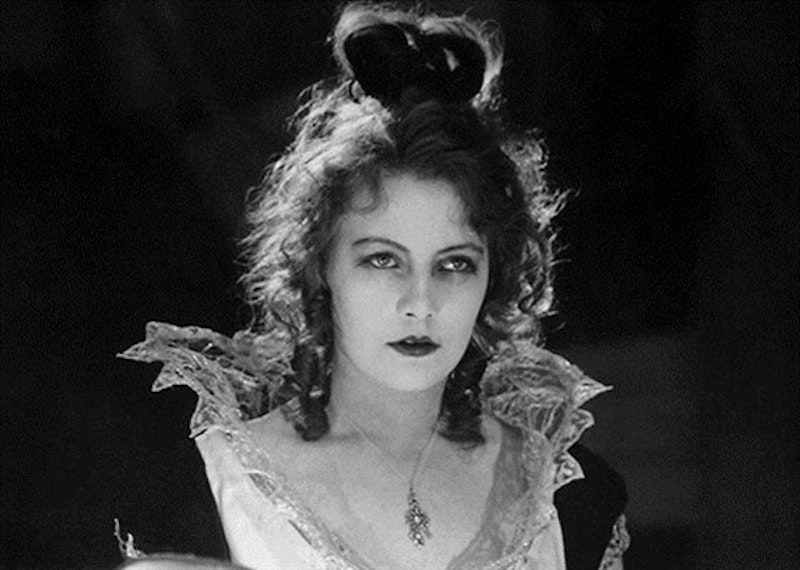Before Greta Garbo became Garbo in Hollywood, she appeared in many Swedish silent films. In her early career, we see a plump young girl with a face that gives off hints of what’s to come later. Garbo was discovered by the film director, Mauritz Stiller, who created the image of Greta Garbo we are familiar with today.
That cold, indifferent stare slowly comes through in Stiller’s epic drama, The Saga of Gösta Berling (1924), a film considered to be the pinnacle of Swedish silent cinema, and served as an inspiration to filmmakers like Ingmar Bergman. Based on an 1891 novel by Selma Lagerlöf, The Saga focuses on the life of a defrocked Lutheran clergyman, Gösta Berling (Lars Hanson), and the people he influences throughout his life. The film, three hours, contains worlds within worlds, interior lives as well as exterior and societal influences upon the characters. The world of 19th-century Sweden is intertwined with Berling’s life story filled with tragedy, despair, and a desire to move toward joy.
The film opens with celebrations on Christmas Eve. Berling is leading the revelry at the estate of Ekeby. Joined by former soldiers (who appear to do nothing but drink), Berling plays a trick on drunken men by summoning a devil (that bears a fascinating resemblance to Krampus). This just turns out to be one of the servants but is strange, an almost Faustian beginning does signal that various forces will be at work in Berling’s life.
Stiller tells the story in many flashbacks. First we see Berling’s expulsion from the Lutheran church, and his job as a tutor to Ebba Dohna, who’s a stepdaughter to the mistress of Borg near Ekeby. The mother is a schemer—she’s manipulating the situation by suggesting that Ebba should marry Berling (who’s considered a commoner), thereby disinheriting Ebba from the Borg estate, which should then neatly end up in the hands of her hapless weak son, Henrik.
Henrik’s married to Elisabeth (Greta Garbo), who clearly doesn’t love him, and instead falls in love with Berling. Naturally, this sets off many troubles at the Borg estate as well as Ekeby Hall. At the end, Berling fights for his life, as he braves wolves on the frozen lake, snow drifts in Sweden’s grand forests, and the final majestic scene of Ekeby Hall ravaged by fire.
Stiller’s film is an epic in every sense of the word, especially in its romanticism. As Garbo biographer, Robert Gottlieb writes, “The movie itself is so elaborate, so stuffed with characters and dramatic scenes, that although her [Garbo’s] role is central, it isn’t determining—not with Lars Hanson and Sweden’s most illustrious older actress, Gerda Lundequist…” Gottlieb’s slightly mocking tone is an intellectual overextension. In fact, Stiller’s film is superb, and Garbo’s acting is mediocre.
Robert Dance, author of The Savvy Sphinx: How Garbo Conquered Hollywood, has a more balanced opinion of the film, rightfully calling it “one of the masterpieces of silent cinema, not because of Garbo’s debut, but rather because of Stiller’s flawless direction of a compelling story, beautifully photographed with a top cast.”
We can’t help but look at silent films through a different technical lens. The acting can be overly dramatic precisely because actors needed to express emotions more intensely. Yet, The Saga never falters or suffers from what we might call “silent film syndrome.” Rather, its story and Berling as the central character hold one by the edge of the seat for an entire three hours. We care what happens to Berling and others, because their emotions and actions (as well as Stiller’s action sequences, especially fire) are imploring us and taking us into their fold.
There are glimpses of what would eventually become “Garbo” in Hollywood, but even Gottlieb admits that Garbo’s acting is “uneven—occasionally powerful feelings emerge through her superb eyes; at other times, she’s tentative. But always she is beautiful.”
Perhaps Gottlieb’s assigning beauty where it doesn’t belong. In The Saga, Garbo looks homely and plain. The role of Elisabeth didn’t come so easily to Greta Gustafsson, as she was known before she took on the name Garbo. Before she was hired for the role, Stiller demanded that she lose weight, and lose she did—20 pounds.
During the filming, the seasoned actors couldn’t comprehend why Stiller spent so much time on an unknown actress, who mainly appeared in Swedish ads. As one actress on the set remarked, “To us she appeared to be just an awkward, mediocre novice.” But Stiller saw Greta Gustafsson much differently. From that point on, Stiller controlled everything Garbo did—all he was interested in having a young girl he could completely mold in his own image.
Stiller was often sadistic toward Garbo, but his discovery of her talent ultimately catapulted and led her into the Hollywood success. As Gottlieb writes, “It was his [Stiller’s] tyranny in conjunction with her combination of determination and malleability that created ‘Greta Garbo.’ Indeed, the most plausible of the various stories about how she became ‘Garbo’ is that he chose the name and bestowed it on her.”
The Saga of Gösta Berling gives us a glimpse into the fact that what matters the most to a great film is a compelling story. Ridding ourselves of any opinions or preconceived notions about Greta Garbo, it’s best to watch Stiller’s masterpiece without future images of Garbo, and see it as a magnificent story of downfall, love, redemption, and renewal of life itself.

